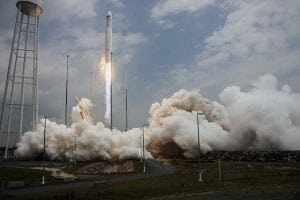Latest News

The Orb-2 Antares launch under the $1.9 billion CRS contract Orbital Science has with NASA. Photo: Orbital Sciences
[Via Satellite 10-17-2016] Orbital Sciences has committed to a new engine for the Antares launch vehicle that it expects will suite both NASA and non-NASA customers. The company did not disclose the engine, nor its manufacturer, but expects it to be ready for a first launch in late 2016 or early 2017.
Orbital Sciences has been attempting for some time to replace the two AJ-26 first-stage engines built by Aerojet Rocketdyne. In 2013 the company filed a lawsuit against United Launch Alliance (ULA) and RD Amross for monopolizing “the market for launch systems and services used for medium class payload missions,” over the Russian RD-180 engine. This lawsuit was later rescinded as political tension built from Russia’s actions in Ukraine, but the search for a replacement continued.
“Back in the summer the company had set an objective about making a decision as to our future main stage propulsion approach by early fall, which we have done,” David Thompson, chairman, president and CEO of Orbital Sciences, said on a third quarter earnings call. “We are very pleased with our decision, it’s going to position Antares to be very competitive in the future, to have a little higher level of payload performance, which will be helpful in a variety of applications.”
Though specifics have not been divulged, Orbital Science was evaluating two alternative Russian engines as well as one U.S. engine, according to statements the company made in April this year. The failure of an AJ-26 engine in May 2014 likely added to the pressure to find an alternative. GenCorp, the parent company of Aerojet Rocketdyne, took a revenue hit due to the subsequent rise in the program’s cost. The company has delivered 10 engines, and has 10 more to deliver before completing its contract, but has incurred costs to repair the test stand damaged in the May incident as well as costs in corrective actions and delayed deliveries.
GenCorp said in a statement that “there can be no assurance that [Aerojet Rocketdyne] will not experience any further issues with one or more of the remaining 10 engines.” Meanwhile Thompson said research and development expenses for a replacement have not been strenuous.
“The costs to make necessary modifications are in line with our prior estimates. Those will be incurred over a couple of years period and will fit comfortably within normal levels of R&D and capital expenditures for the company,” he said. “We have an adequate supply of our current engines to overlap for six months or longer in the event there were any delays in the new system. I don’t think there will be, but we’re covered just in case.”
Orbital Sciences has been gradually improving the cost-efficiency of Commercial Resupply Services (CRS) launches for NASA, to which it attributed an $8 million increase in segment operating income compared to the same quarter last year. Thompson said the next launch, the CRS mission known as Orb-3, will incorporate performance upgrades to Antares, and by the end of the year “Block 2” versions of both Antares and Cygnus will be in service.
“Orbital continues to assemble a commercial Antares manifest (Orbital submitted its first non-NASA proposal during 1Q) and still expects an inaugural commercial-mission between late 2016 and early 2017,” wrote Chris Quilty, SVP of equity research at Raymond James & Associates. “However, management refrained from providing additional color on what engine will power these missions. As a reminder, management has previously stated the cost up to $30 million to re-engine the Antares with a new liquid or solid propulsion system.”
Thompson did not identify who, besides NASA, is interested in launching aboard Antares, but said Orbital Sciences is currently in a couple of competitions.
We have briefed several customers both inside and outside of NASA on our plans and I think they see the logic of what we are doing, and appear to be comfortable with it,” said Thompson.
Despite the rocket’s ongoing evolution, he said those interested have not been dissuaded by the now imminent change in propulsion systems.
Get the latest Via Satellite news!
Subscribe Now